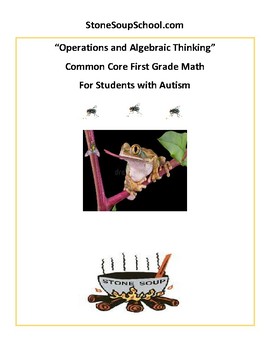Grade 1 - CCS: Operations and Algebra For Students with Autism
- PDF
- Internet Activities
Also included in
- For Kindergarten through 2nd Grade Students with AutismInstructors who use this variety of instructional modes will enhance learning for students with Autism. Students on the spectrum need a multi-media approach including: visual images, an auditory reinforcement, a tactile involvement and key wordPrice $86.67Original Price $96.30Save $9.63
- For First Grade Students with AutismInstructors who use this variety of instructional modes will enhance learning for students with Autism. Students on the spectrum need a multi-media approach including: visual images, an auditory reinforcement, a tactile involvement and key words presented in diffPrice $14.13Original Price $15.70Save $1.57
- Students on the autism spectrum need a multi-media approach including: visual images, an auditory reinforcement, a tactile involvementPrice $6.95Original Price $8.85Save $1.90
Description
“Operations and Algebraic Thinking” - First Grade Math
This educational resource pack enhanced with : color coding, visual images and sound recordings. The instructor will require a media app that plays wav files. To save ink and paper, an application like Google Classroom could be utilized.
This educational resource pack includes: Understanding addition as putting together and adding to, and understand subtraction as taking apart and taking from. Represent addition and subtraction with objects, fingers, mental images, sounds (e.g., claps), acting out situations, verbal explanations, expressions, or equations.
Operations and Algebraic Thinking - represent and solve problems involving addition and subtraction.
Use addition and subtraction within 20 to solve word problems involving situations of adding to, taking from, putting together, taking apart, and comparing, with unknowns in all positions, e.g., by using objects, drawings, and equations with a symbol for the unknown number to represent the problem.
Solve word problems that call for addition of three whole numbers whose sum is less than or equal to 20, e.g., by using objects, drawings, and equations with a symbol for the unknown number to represent the problem. understand and apply properties of operations and the relationship between addition and subtraction.
Apply properties of operations as strategies to add and subtract. (Note: Students need not use formal terms for these properties.) Examples: If 8 + 3 = 11 is known, then 3 + 8 = 11 is also known. (Commutative property of addition.) To add 2 + 6 + 4, the second two numbers can be added to make a ten, so 2 + 6 + 4 = 2 + 10 = 12. (Associative property of addition.)
Understand subtraction as an unknown-addend problem. For example, subtract 10 – 8 by finding the number that makes 10 when added to 8. add and subtract within 20.
Relate counting to addition and subtraction (e.g., by counting on 2 to add 2).
Add and subtract within 20, demonstrating fluency for addition and subtraction within 10. Use strategies such as counting on; making ten (e.g., 8 + 6 = 8 + 2 + 4 = 10 + 4 = 14); decomposing a number leading to a ten (e.g., 13 – 4 = 13 – 3 – 1 = 10 – 1 = 9); using the relationship between addition and subtraction (e.g., knowing that 8 + 4 = 12, one knows 12 – 8 = 4); and creating equivalent but easier or known sums (e.g., adding 6 + 7 by creating the known equivalent 6 + 6 + 1 = 12 + 1 = 13). Work with addition and subtraction equations.
Understand the meaning of the equal sign, and determine if equations involving addition and subtraction are true or false. For example, which of the following equations are true and which are false? 6 = 6, 7 = 8 – 1, 5 + 2 = 2 + 5, 4 + 1 = 5 + 2.
Predictable language with: tactile, visual and auditory prompts for students with Autism. Students on the spectrum need a multi-media approach including: visual images, an auditory reinforcement, a tactile involvement and key words presented in different contexts 3 - 5 times.
Here is a link to our teaching strategies for students with autism: https://www.teacherspayteachers.com/Product/Autism-Spectrum-Educational-Treatments-1023424
Here is a link to additional worksheets for students with autism:
https://www.teacherspayteachers.com/Store/Stone-Soup-School/Category/Autism-Spectrum-141203
Click here to Stone Soup School and new products:
https://www.teacherspayteachers.com/Sellers-Im-Following/Add/Stone-Soup-School
Please help us out by rating this product.
Thank You!








